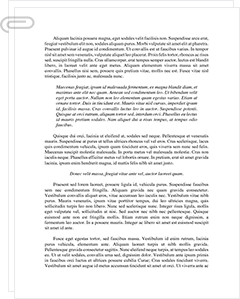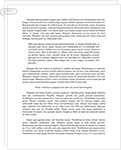 Study Document
Study Document
United States Federal Reserve System: The Federal Essay
United States Federal Reserve System:
The Federal Reserve System or the Fed was established by President Wilson in December 1913 to promote the development of a stable, flexible, and safer financial system in the country. President Wilson enacted the Federal Reserve Act, which was a conclusion of the findings of a commission that was mandated with the task of examining the 1907 severe bank panic. Since its inception, the Federal Reserve System has served as the gatekeeper of the U.S. economy and the country's central bank. Furthermore, this financial institution regulates other monetary institutions, affects the economy, and controls America's money. The Fed achieves its functions by carrying out various activities that either slows down or stimulate the economy. The main duties of the Fed include conducting U.S. monetary policy, offering financial services and liquidity, and supervising and regulating banks.
Federal Reserve and the Discount Rate:
Discount rate can be described as the interest banks pay when they borrow finances urgently and directly from one of the Federal Reserve banks (Kennon, n.d.). Since the Fed has the ability to affect the direction of interest rates, it also adjusts the discount rate based on a consideration of various factors. Some of the factors that influence the Federal Reserve in adjusting the discount rate include the state of the economy, increase or decrease of money supply, borrowing by commercial banks, and banks' lending activities. The other factor that affects the adjustment of the discount rate by the Fed is the probability that the economy is likely to undergo a recession. While this is not a common factor, it forces the Federal Reserve to decrease the discount rate and establish expansionary fiscal policy. However, inflation can also contribute to adjustments in the discount rate since the likelihood of higher inflation forces the Fed to increase the discount rate and establish contractionary financial policy.
The Discount Rate and Bank Specific Interest Rates:
The discount rate plays a significant and wider role in the overall fiscal policy because it's a vivid announcement of changes in the Federal Reserve's monetary policy. While higher discount rates are indicators of more restraining financial policies, lower rates are signals of less limiting policies. Due to its importance in the economy, the discount rate has a significant impact on decisions of banks in establishing their specific interest rates. Changes in the discount rate not only affect the economy's open market interest rates but they also affect lending rates. The effect on the lending rates either makes it more or less costly for banks to obtain money to lend or hold. Through decreasing or increasing the discount rate, the Federal Reserve System can encourage or discourage borrowing, which in turn changes the revenue banks can obtain for making loans.
Monetary Policy and Inflation:
Inflation is usually a by-product of increases in the supply of money at a faster rate than the underlying economy. On the other hand, monetary policy can be regarded as the process of increasing or decreasing the supply of money. As a result, monetary policy has a significant impact on inflation and demand for goods and services in the entire economy ("How Does Monetary Policy Influence Inflation and Employment?" 2013). Therefore, monetary policy influences the financial conditions experienced by businesses and households.
The significant impact of monetary policy on inflation is evident when the federal funds rate is minimized, which contributes to stronger demand for goods and services. This increases wages and other costs, which is an indication of the huge demand for materials and employees that are needed for production. Generally, monetary policy seeks to avoid inflation through keeping the money supply stable.
Monetary Policy and Money Supply:
Since monetary policy basically involves increasing or decreasing the supply of money in an economy, it is generally used to control money supply. The Federal Reserve uses three major elements to control…
Sample Source(s) Used
References:
Bartlett, B. (2009, January 23). Does Stimulus Stimulate? Forbes. Retrieved July 28, 2013,
from http://www.forbes.com/2009/01/22/stimulus-keynes-taxes-oped-cx_bb_0123bartlett.html
Beggs, J. (n.d.). Bank Reserves and the Discount Rate. Retrieved July 28, 2013, from http://economics.about.com/od/monetaryandfiscalpolicy/a/bank_reserves.htm
"How Does Monetary Policy Influence Inflation and Employment." (2013, May 23). Board of Governors of the Federal Reserve System. Retrieved from The Federal Reserve website: http://www.federalreserve.gov/faqs/money_12856.htm
Related Documents
 Study Document
Study Document
United States Federal Reserve System Factors That
United States Federal Reserve System Factors that influence the Federal Reserve in adjusting the discount rate Interest rates are charged for loans to commercial banks. In accordance to the rules and regulations of the Federal Reserve, this is a principle that can be used as a means of controlling the money supply. An increase in the level of the money supply is achieved when the Federal lowers the rates of discount. A
 Study Document
Study Document
Banking US Federal Reserve /
S. government is limping along. Across the Atlantic, the fallout from the crisis has been even worse. Greece is broke. Ireland is broke. And Spain looks like it's about to go broke. Ireland suffered because, because after having implementing the euro, its interest rates were positioned by a European central bank more familiar with French needs than Irish ones. Ireland's financial system including its tax cuts and public service bloat
 Study Document
Study Document
Federal Reserve System More Commonly
" (Structure of the Federal Reserve System) The 12 Federal Reserve Banks extend banking service to the depository institutions and also to the federal government. To the financial institutions it takes the responsibility of maintaining reserve and clearing out accounts and entails various payment services incorporating checks, electronically transferring funds and circulating and receiving coins and currency notes. As the banker of the Federal Government they function as fiscal agents. They
 Study Document
Study Document
USA Financial System Financial System
Through these functions the federal system the Federal Reserve System manages the money supply in the U.S. leading to maximum employment, and stabilizing of prices hence preventing deflation or inflation. It stabilizes the financial system and contains any systemic risks that can come up in financial markets. Impact of interest rates on the U.S. And the global financial environment A change in interest rates impacts the U.S. And Global financial environment
 Study Document
Study Document
Federal Reserve Operations in the United States
Federal Reserve Operations in the United States Functions of the Federal System in Control of Money Supply The discount rate, according to the federal system, is the interest rate, which the Federal Reserve imposes on the loans it gives to Federal Banks that are troubled and need financial support. Processing of lending to the banks is done through the 'discount window', which in most cases is controlled by the Reserve Banks. Factors influencing
 Study Document
Study Document
Federal Reserve System Exists As
This is the interest rate that banks lend their balances on at the Federal Reserve to other banks. It exercises this control by influencing the demand for and supply of these balances through the following means: Open market operations -- the purchase or sale of securities, primarily U.S. Treasury securities, in the open market to influence the level of balances that depository institutions hold at the Federal Reserve Banks (The



